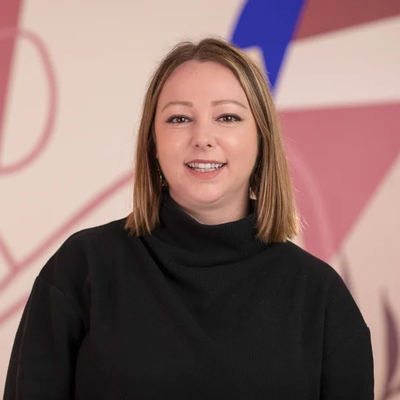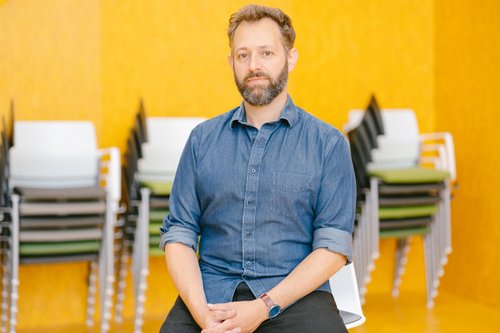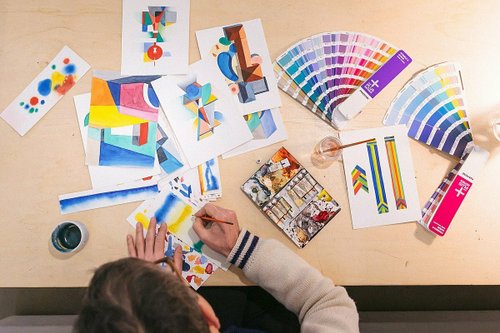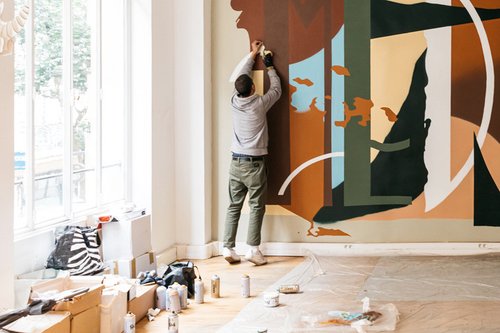5 books to boost your creativity at work
04. 10. 2023
5 min.


US Editor at Welcome to the Jungle
The idea that creativity is the preserve of an artistic elite is being challenged in a number of new books. As many Silicon Valley start-ups have shown, we all have the potential to innovate – regardless of background or training. Creativity can thrive anywhere, even in corporate boardrooms and tech hubs. Of the many new books on the topic, Welcome to the Jungle has chosen five that can help you find your spark and empower you to embrace your role as a modern-day imaginative thinker. The overarching message is that creativity is not the privilege of a few but the potential of many. Dive into these pages and discover the tools to transform your workspace into a hub of creativity and change.
The Creative Act: A Way of Being (2023) by Rick Rubin
Overview
In his exploration of the artistic journey, Rick Rubin, the American record producer and executive who co-founded Def Jam Recordings, shares strategies and lessons from his interactions with a wide range of artists, including RunDMC, Metallica and Johnny Cash. Rubin’s central premise is that creativity is an innate human trait. “Creativity is a fundamental aspect of being human. It’s our birthright. And it’s for all of us,” he writes. This guide offers techniques to enhance awareness, draw inspiration from unexpected places, and turn unique creative “seeds” into full-fledged masterpieces. This isn’t just a call to embrace creativity; it’s a toolkit for thriving in a rapidly evolving professional landscape where innovation is currency. Rubin says that anyone, including those in contemporary workplaces, can fully engage with and benefit from the creative process if they commit to their craft and are willing to make mistakes.
Key takeaways
- Learn to observe carefully: Rubin writes that true creativity stems from profound observation: “The ability to look deeply is the root of creativity, seeing the awe behind the obvious.” One can come up with novel insights and ideas by looking beyond superficialities.
- Nurture your curiosity: Be relentlessly curious, always seeking to learn, understand, and explore if you want to ignite your creative spirit.
- Embrace new experiences: Taking the road less traveled, experimenting with unfamiliar experiences, and diving into the unknown can lead to unexpected creative revelations.
The Imagination Muscle (2024) by Albert Read
Overview
This is a clarion call to modern workers to reframe their perspectives on creativity and imagination. Albert Read, the managing director of Condé Nast Britain, challenges the habit of viewing imagination as a luxury. Instead, the former journalist says it is like a muscle: trainable, developable, and essential for personal and professional fulfillment. This book delves into the origins and evolution of ideas – from pre-historic times up to the 21st century. It highlights the indomitable spirits of figures such as the inventor Thomas Edison, the visionary urbanologist Jane Jacobs, and the ingenious tech founder Steve Jobs. Read’s proposition is clear: In our rapidly advancing Age of Technology, nurturing our “imagination muscle” is not just a matter of personal growth but a necessity.
Key takeaways
- Imagination has no limits: Imagination is boundless in potential, and its proper channeling can lead to immense personal and professional growth. Read provides methods to find ideas and cultivate observational skills, making one more attuned to mental shifts and patterns.
- You can harness your imagination: As technology reshapes our world, reclaiming and reinforcing our imaginative prowess is crucial. It’s our greatest asset in navigating the uncertainties of the future.
Lateral Thinking for Every Day: Extraordinary Solutions to Ordinary Problems (2023) by Paul Sloane
Overview
Paul Sloane is no stranger to creativity. With more than 30 books on lateral thinking and innovation, the founder of the Lateral Thinking Group defines his method as “the ability to look at a problem from a fresh perspective and to come up with new and unconventional solutions.” Sloane writes, “Traditional problem-solving methods focus on finding the best solution to a problem. Lateral thinking, on the other hand, focuses on finding any solution, even if it’s not the best.” It enhances creativity by breaking established patterns, encouraging innovative solutions, and broadening the scope of possibilities. Sloane offers a revitalized approach to innovation and creativity when tackling daily challenges. This practical guide contains exercises and techniques to improve thinking outside the box.
Key takeaways
- Unusual perspectives give fresh answers: Sloane doesn’t just theorize, he introduces actionable steps to follow. These include the “forced relationship technique,” which involves finding a connection between two seemingly unrelated items. Another is the “unusual questions technique,” which involves challenging conventional thought patterns. Lastly, there’s the “simplification technique,” which advocates breaking down complexity to reveal the core of a problem.
- Practicing the methods pays off: This is a tool, not just an interesting read. To maximize its impact, Sloane advises engaging with the content systematically. Active involvement in the exercises and consistent documentation of the learning journey will pay dividends.
Anatomy of a Breakthrough: How to Get Unstuck and Thrive When It Matters Most (2023) By Adam Alter
Overview
Adam Alter, a professor of marketing at New York University’s Stern School of Business, delves into the complex nature of breakthroughs in this book. They don’t emerge from a singular eureka moment, he writes, but are the culmination of an arduous process that involves overcoming barriers. Alter categorizes these barriers as heart (emotions that hinder progress), head (counterproductive thought patterns), and habit (limiting behaviors). Alter sheds light on the symbiotic relationship between innovative thinking and consistently tackling these barriers. His findings can help those striving to harness their creativity to come up with transformative solutions and groundbreaking ideas.
Key takeaways
- Embrace failure: Alter writes, “The fear of failure is a major obstacle that prevents many people from achieving breakthroughs.” This failure is “often the best way to learn and grow,” he adds, urging readers to view setbacks as valuable aspects of the learning process.
- Experiment and collaborate: “Don’t be afraid to try new things. The more you experiment, the more likely you are to find a solution that works,” Alter writes. He highlights the value of collaboration, suggesting that pooling diverse perspectives can lead to richer solutions.
- Take care of yourself and be patient: Alter emphasizes the link between well-being and innovation. “It’s important to take care of your physical and mental health if you want to achieve a breakthrough,” he writes. He couples this with a call for persistence, noting that breakthroughs demand time and effort.
Awaken Your Genius: Escape Conformity, Ignite Creativity, and Become Extraordinary (2023) By Ozan Varol
Overview
Ozan Varol, a rocket scientist, law professor, and author, offers a compelling idea: “We are all born with the potential to be creative geniuses.” Yet, the societal conditioning we undergo from a young age teaches risk aversion and rule adherence, often smothering our creative spirit. This tendency to play safe and try to find the ‘right way’ to do things prevents us from venturing into uncharted territory, which is where we can experience creativity. Creativity is the cornerstone of innovation, which is essential for businesses to thrive in a world of relentless change. However, the hierarchical structure in many workplaces tends to shackle creative potential. Varol writes that businesses must become places where risks are embraced, and divergence is celebrated if they are to progress and become hubs of creativity.
Key takeaways
- Challenge conformity: Routinely question established norms and methods when performing tasks. Doing so will open doors to innovative approaches that might be more effective.
- Take calculated risks: While respecting the boundaries of your professional environment, be willing to venture outside your comfort zone with new strategies or ideas. Understand that setbacks are part of growth.
- Seek out opportunities to collaborate: Engage with colleagues from diverse departments or teams. Their perspectives can provide fresh angles to your projects, leading to more holistic and creative solutions.
- Create small pockets of innovation: Find small ways to experiment within your role or department, even if your larger workplace environment doesn’t actively promote creativity.
- Prioritize self-care: Your mental and physical well-being is directly linked to your creative output. Ensuring you’re mentally and physically in optimal health can enhance your creativity and productivity.
Photo: Welcome to the Jungle
Follow Welcome to the Jungle on Facebook, LinkedIn, and Instagram to get our latest articles every day, and don’t forget to subscribe to our newsletter!

Další inspirace: Kreativita

How creativity became corporate religion
By idolizing the image of the feverishly driven artist, capitalism created new ways to exploit workers
05. 9. 2023

Learn to boost your creativity (and let go of your fears)
No one is immune to the effects that negative feedback can have on their creativity. Danielle Krysa, the author of Your Inner Critic is a Big Jerk...
21. 2. 2022

Take a walk to boost your health and creativity
The simple act of taking a walk improves our general wellbeing, focuses our attention and boosts our creativity.
14. 4. 2021

Costume drama: exploring the creative process with designer Lorna Mugan
She’s been nominated for a Bafta and an Emmy, but it’s unlikely you’ll recognise her face. Meet Lorna Mugan, a costume designer from Donegal.
12. 10. 2020

In lockdown and running out of ideas? Six tips to stay creative
Whether it’s through creating art or just finding inventive ways to adapt at work to this strange time, being creative is a new survival skill.
12. 5. 2020
Zpravodaj, který stojí za to
Chcete držet krok s nejnovějšími články? Dvakrát týdně můžete do své poštovní schránky dostávat zajímavé příběhy, nabídky na práce a další tipy.

Hledáte svou další pracovní příležitost?
Více než 200 000 kandidátů našlo práci s Welcome to the Jungle
Prozkoumat pracovní místa